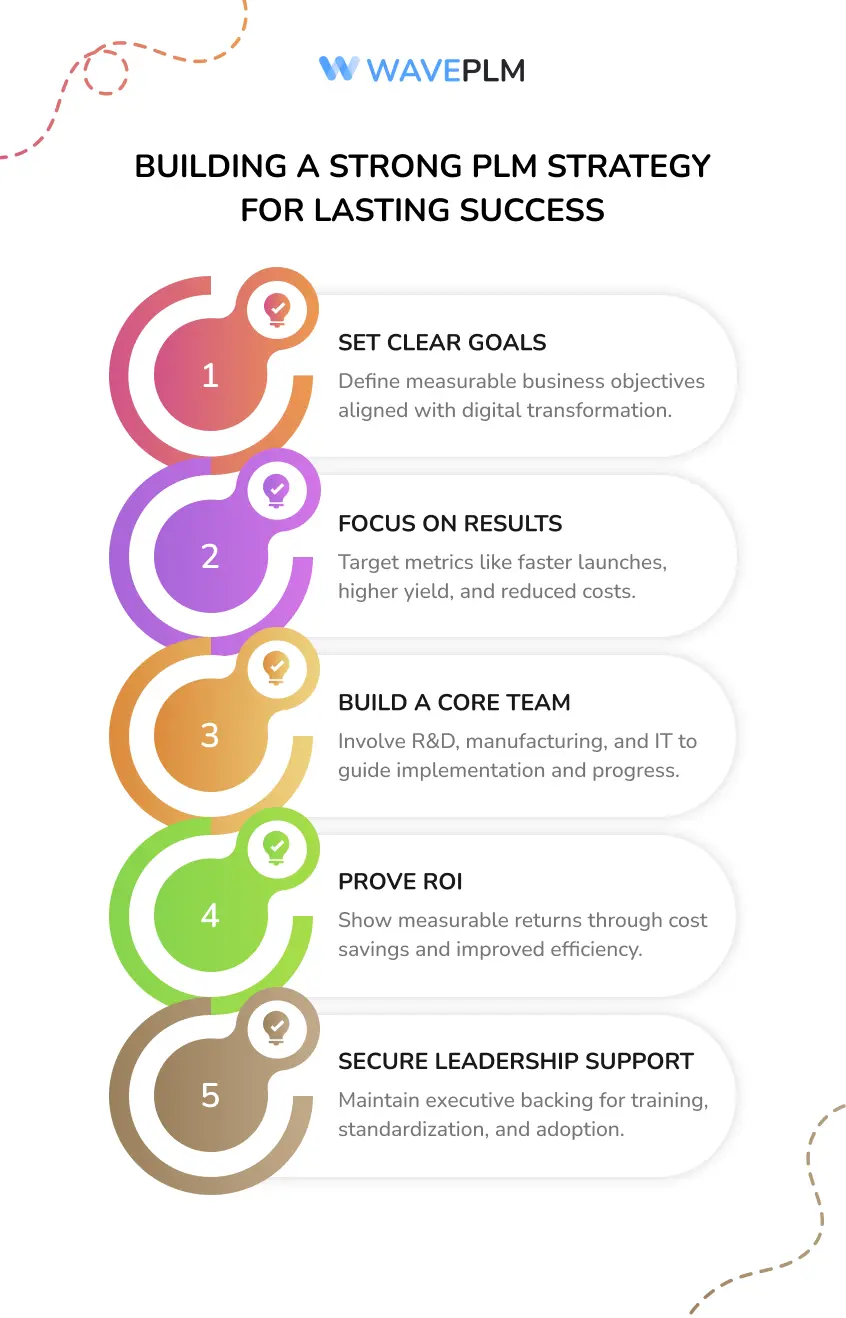
Key Takeaways
- Successful PLM implementation requires clear strategic objectives, cross-functional team collaboration, and comprehensive data governance to achieve measurable business outcomes
- Organizations typically see 25-40% reduction in product development time and 15-30% cost savings when following proven PLM best practices
- The most critical success factors include selecting vendor-neutral PLM solutions, ensuring seamless integration with existing ERP and CAD systems, and maintaining data accuracy above 95%
- Effective change management and user training programs achieve 80%+ user adoption rates within the first 6 months of PLM deployment
- Continuous improvement through KPI monitoring and regular system optimization drives long-term PLM success and ROI maximization
Product lifecycle management has become the backbone of modern manufacturing excellence, with the global PLM market reaching $43 billion in 2025. Yet despite this massive investment, many organizations struggle to realize the full potential of their PLM initiatives. The difference between successful implementation and costly failure often comes down to following proven plm best practices that address both technical and organizational challenges.
Companies that implement PLM effectively report remarkable results: 20-50% faster time-to-market for new products, 30% fewer engineering change errors, and 25% improvement in product data search efficiency. However, achieving these outcomes requires more than just purchasing PLM software — it demands a comprehensive strategy that encompasses data governance, technology integration, user adoption, and continuous optimization.
This guide provides manufacturing leaders with actionable plm best practices derived from successful implementations across automotive, aerospace, medical device, and other complex industries. Whether you’re planning your first PLM project or looking to optimize an existing system, these strategies will help you maximize ROI and drive measurable business results.

Strategic Foundation for PLM Excellence
Building a robust foundation for product lifecycle management begins with establishing clear, measurable business objectives that align with your organization’s broader digital transformation goals. Successful plm implementation starts with executive sponsorship and a well-defined PLM strategy that connects directly to bottom-line results.
The most effective PLM initiatives target specific, quantifiable outcomes such as reducing time-to-market by 30%, improving first-pass yield by 20%, or cutting product development costs by 15%. These objectives should be embedded within your organization’s Industry 4.0 roadmap and supported by dedicated funding allocated over 18-24 months for full implementation and optimization.
Creating a cross-functional PLM steering committee with representatives from R&D, manufacturing, quality, supply chain management, and IT ensures that all key stakeholders have input into the PLM strategy. This committee should meet monthly during implementation and quarterly thereafter to review progress against established key performance indicators and adjust tactics as needed.
Your business case must demonstrate clear ROI projections, typically showing payback within 18-24 months through reduced engineering change order processing time, elimination of duplicate parts, improved regulatory compliance efficiency, and faster new product introduction cycles. Companies that establish this financial foundation early are 60% more likely to achieve their intended PLM objectives.
Executive sponsorship extends beyond initial approval—it requires ongoing advocacy for change management, resource allocation for training programs, and support for process standardization across global operations. Organizations with sustained C-level commitment report 40% higher user adoption rates and significantly better long-term success with their PLM initiatives.

Data Management and Governance Excellence
The cornerstone of any successful plm system lies in robust data management practices that ensure accuracy, consistency, and accessibility across the entire organization. Implementing master data management protocols with standardized part numbering schemes and classification taxonomies prevents the data chaos that derails many PLM projects.
Establishing data quality metrics with targets of 99%+ accuracy for critical product attributes and BOM structures requires automated validation workflows that prevent duplicate parts and inconsistent specifications from entering the system. These workflows should include mandatory field validations, approval checkpoints, and real-time duplicate detection algorithms that flag potential issues before they impact downstream processes.
Version control mechanisms must ensure a single source of truth for all product documentation while maintaining comprehensive audit trails that comply with ISO 9001, FDA 21 CFR Part 11, and industry-specific regulations. This includes implementing check-in/check-out procedures for design files, automatic versioning for engineering changes, and secure access controls that track who accessed what information when.
Data governance extends to existing data migration from legacy systems, which often represents the most complex and time-consuming aspect of plm implementation. Organizations should plan for 6-12 months of data cleansing and migration activities, with dedicated resources to identify relevant data sources, validate data integrity, and establish ongoing data stewardship roles.
The most successful implementations appoint data stewards within each functional area who are responsible for maintaining data integrity and ensuring compliance with established governance policies. These stewards work closely with the PLM platform administrators to monitor data quality metrics and implement corrective actions when issues arise.
Technology Selection and Integration Best Practices
Selecting the right plm solution requires careful evaluation of vendor capabilities against your specific industry requirements, scalability needs, and integration ecosystem. The most critical factors include industry-specific functionality, scalability to support 10,000+ users, cloud deployment options, and robust API architectures that enable seamless connectivity with existing systems.
Modern PLM solutions must integrate seamlessly with major CAD systems including SolidWorks, AutoCAD, and CATIA, as well as ERP platforms like SAP and Oracle, and manufacturing execution systems (MES) that provide real-time production feedback. This integration enables automated workflows such as releasing approved designs directly to manufacturing and updating BOMs in real-time based on engineering changes.
API-first architectures have become essential for supporting real-time data synchronization, mobile accessibility for field engineers, and future technology evolution including AI/ML capabilities and IoT device integration. Organizations should prioritize PLM vendors that provide comprehensive REST APIs, pre-built connectors for common enterprise systems, and flexible customization options.
Cybersecurity measures must include multi-factor authentication, role-based access controls with regular permission audits, data encryption at rest and in transit, and compliance with SOC 2 Type II standards. With increasing cyber threats targeting intellectual property, implementing robust security protocols protects both product data and competitive advantages.
The PLM vendor selection process should include proof-of-concept testing with your actual product data, reference calls with companies in similar industries, and detailed total cost of ownership analysis that includes licensing, implementation, integration, training, and ongoing support costs over a 5-year period.
User Adoption and Change Management
Achieving high user adoption rates requires a comprehensive change management strategy that addresses both technical training and cultural transformation. Organizations that invest in structured training programs and ongoing support typically achieve 80%+ user adoption rates within the first 6 months of PLM deployment.
Implementing plm successfully depends on establishing a network of PLM champions with approximately one super-user per 15-20 end users across all departments. These champions receive advanced training, serve as local experts for their teams, and provide feedback to the implementation team about user needs and challenges.
Training Program Structure
Effective training programs follow a structured approach that begins with pre-implementation awareness sessions covering PLM benefits and upcoming changes, followed by role-based functional training lasting 2-4 days depending on user complexity. This should be supplemented with post-implementation refresher courses and advanced feature workshops as users become more comfortable with the system.
Regular lunch-and-learn sessions highlighting new capabilities and best practices help maintain engagement and encourage adoption of advanced features. Creating role-specific training curricula with hands-on workshops, video tutorials, and certification programs ensures that users can quickly become productive with their new plm processes.
Phased rollout strategies that start with pilot groups of 50-100 users before enterprise deployment allow organizations to refine training materials, identify workflow issues, and build internal success stories that encourage broader adoption. User feedback mechanisms through monthly surveys and quarterly focus groups provide ongoing insights for continuous improvement.

Providing ongoing support through dedicated help desk services and comprehensive knowledge bases with 24/7 availability ensures that users can quickly resolve issues and continue productive work. The most successful implementations also establish regular office hours where PLM experts are available for one-on-one assistance and advanced troubleshooting.
Process Optimization and Workflow Design
Optimizing business processes before implementing plm technology ensures that you’re not simply automating inefficient workflows. The most effective approach involves mapping current state processes to identify bottlenecks, redundancies, and approval delays that exceed 5 business days, then designing future state workflows that eliminate these inefficiencies.
Successful process optimization typically reduces manual handoffs by 60% through automated routing of engineering changes, approval notifications, and document distribution. This includes implementing parallel processing capabilities that enable concurrent engineering activities and design validation processes that previously occurred sequentially.
Establishing standardized change control processes with defined criteria for emergency, standard, and major changes ensures consistent handling of engineering modifications while maintaining quality and compliance standards. These processes should include automated escalation procedures for exception handling and conflict resolution that resolve issues within 48 hours.
The most impactful workflow improvements often involve streamlining processes between different functional areas such as engineering, manufacturing, and quality. For example, implementing automated workflows that trigger procurement activities when engineering releases new parts, or automatically updating manufacturing work instructions when design changes are approved.
Organizations should focus on streamlining processes that directly impact time to market, such as design review cycles, supplier qualification procedures, and regulatory submission workflows. By identifying and eliminating non-value-added activities, companies typically achieve 25-40% reductions in overall product development cycle times.
Performance Measurement and KPI Tracking
Measuring success requires establishing baseline metrics before plm implementation and tracking improvement against specific key performance indicators throughout the deployment and optimization phases. The most valuable metrics focus on business outcomes rather than system utilization statistics.
Time-to-market metrics should target 25% reduction in new product introduction cycles through improved collaboration, automated workflows, and reduced rework cycles. This includes tracking both overall development timelines and specific milestone achievements such as design freeze, prototype completion, and regulatory approval.
Design reuse rates represent a critical measure of PLM value, with best-in-class organizations achieving 40%+ component standardization across product families. This metric directly impacts both development costs and manufacturing efficiency while reducing supply chain complexity and inventory requirements.
Change order processing time provides insight into workflow efficiency, with goals of 72-hour turnaround for standard modifications and clear escalation procedures for complex changes. Tracking this metric helps identify bottlenecks in approval processes and opportunities for further automation.
Collaboration metrics including cross-functional team participation, document sharing frequency, and supplier engagement levels indicate how effectively PLM is breaking down organizational silos and improving communication. These leading indicators often predict downstream improvements in product quality and customer satisfaction.
Total cost of ownership reduction through eliminated rework, improved first-pass success rates, and faster time to market typically delivers 300%+ ROI over 5 years for organizations that effectively implement plm best practices and maintain focus on continuous improvement.
Common Implementation Pitfalls to Avoid
Even well-planned PLM projects can encounter significant challenges that delay implementation and reduce ROI. Understanding these common pitfalls helps organizations proactively address potential issues before they become project-threatening problems.
Rushing deployment without adequate data cleansing results in 40%+ data quality issues post-go-live, including duplicate parts, inconsistent specifications, and incomplete BOMs that compromise system reliability. Organizations should allocate 25-30% of their implementation timeline to data preparation and validation activities.
Underestimating integration complexity frequently leads to project delays averaging 6-12 months beyond original timelines, particularly when connecting PLM with legacy ERP systems or specialized engineering applications. Conducting thorough technical assessments and proof-of-concept testing before committing to implementation schedules helps set realistic expectations.
Insufficient executive support manifests as user resistance and adoption rates below 50%, often because middle management doesn’t prioritize PLM training or process changes. Maintaining visible C-level advocacy throughout implementation and celebrating early wins helps sustain organizational momentum.
Overlooking mobile accessibility requirements limits field engineer engagement and supplier collaboration, reducing the value of extended supply chain integration. Modern PLM solutions should provide responsive interfaces that work effectively on tablets and smartphones for users who need access outside traditional office environments.

Neglecting backup and disaster recovery planning risks business continuity during system outages or cyber incidents. Implementing robust backup procedures, testing recovery processes regularly, and maintaining offline access to critical product data ensures operational resilience.
Advanced PLM Capabilities and Future Trends
Leading organizations are leveraging artificial intelligence within their plm technology to automate design optimization, predict maintenance requirements, and identify potential quality issues before they impact production. These AI-enhanced capabilities typically deliver 15-25% improvements in engineering productivity and 30-40% reductions in field failures.
Digital twin technology represents the next evolution of product lifecycle management plm, enabling real-time product performance monitoring and simulation that feeds back into future design improvements. Organizations implementing digital twins report 20-35% reductions in warranty costs and significantly improved customer satisfaction through proactive maintenance.
Sustainability metrics integration is becoming essential as regulatory and consumer pressures mount, with PLM platforms extended to track carbon footprint, recyclability, and circular economy initiatives throughout the entire lifecycle. This capability is particularly critical for companies subject to emerging environmental regulations and customer sustainability requirements.
Augmented reality tools integrated with plm systems enhance collaboration between distributed teams and enable remote troubleshooting capabilities that reduce travel costs and accelerate problem resolution. Early adopters report 40-50% reductions in field service costs and improved first-time fix rates.
Blockchain technology is emerging as a solution for supply chain traceability and intellectual property protection, providing immutable records of product changes, supplier qualifications, and design ownership that support regulatory compliance and competitive protection.
FAQ
What is the typical timeline for PLM implementation in manufacturing companies?
Most organizations require 12-18 months for full PLM deployment, including 3-4 months for system configuration, 2-3 months for data migration, 4-6 months for phased rollout, and 3-5 months for optimization and stabilization. The timeline can extend to 24 months for complex global implementations or highly regulated industries that require extensive validation and compliance activities.
How do you ensure data security and compliance in cloud-based PLM systems?
Implement multi-layered security including encryption at rest and in transit, role-based access controls with regular permission audits, SOC 2 Type II certified hosting, and compliance frameworks meeting FDA, ISO 27001, and industry-specific regulations. Additionally, establish clear data governance policies, regular security assessments, and incident response procedures that protect intellectual property while enabling collaboration.
What are the most critical integrations for PLM success beyond ERP and CAD systems?
Essential integrations include quality management systems (QMS) for CAPA tracking, supplier portals for collaborative design, MES systems for manufacturing feedback, and business intelligence platforms for advanced analytics and reporting. Other valuable integrations include document management systems, regulatory submission platforms, and customer relationship management tools that provide end-to-end product visibility.
How do you measure ROI from PLM implementation and what benchmarks should organizations target?
Calculate ROI through reduced development costs (15-30% savings), accelerated time-to-market (20-40% improvement), decreased rework (50-70% reduction), and improved compliance efficiency. Target breakeven within 24 months with 300%+ ROI over 5 years. Track leading indicators such as user adoption rates, data quality metrics, and process cycle times to predict long-term success.
What strategies work best for managing PLM adoption in global organizations with diverse cultural and technical environments?
Implement regional deployment strategies with local champions, culturally adapted training materials in native languages, flexible workflows accommodating regional business practices, and 24/7 global support coverage ensuring consistent user experience across time zones. Establish clear communication protocols, regular virtual collaboration sessions, and standardized processes that maintain global consistency while allowing for local adaptation.




